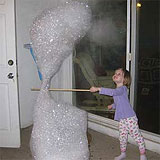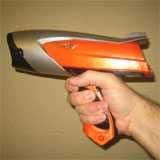The Secret Advantage of Coors Light Beer Cans - page 2
That night, after the kids were asleep I tried a more direct, controlled version of the experiment.
I invited Odie over to help.

For this second part of the experiment, I set up a 300 watt heat lamp. This bulb was hot, more than 250°F, and it was a powerhouse of radiated heat. I used a kitchen trivet under the can to prevent heat conduction into or out of the table.
Would the silver can be able to deflect this onslaught of radiant heat?

I prepared two types of beer cans, Coors light and Bud Light in the refrigerator. The beer started at 38°F.
I'd heat each can for 20 minutes with the heat lamp, then measure the temperature change. The Coors light can was first.
The heat lamp was pointed directly at the beer can, positioned nine centimeters away.

At first, the thermometer showed almost no change in the beer temperature. I had figured the can would be boiling hot after 15 minutes. That didn't happen.

At the end, the can was up to 55.3°F, an increase of 16.8°F.

Next it was time for the Bud Light. The Bud Light can is blue with silver and red details. I was sure it would absorb more heat from the relentless heat lamp. Because the can of Bud Light is a little shorter than the Coors can, I propped it up on a magazine.

In 20 minutes, I could see that I had been wrong. The Bud Light can, which had started at 38°F, finished the bake cycle at 54.7°F! It was cooler than the Coors Light had been!
My hypothesis was crushed. The silver can hadn't been a benefit to Coors Light at all.
Start Temp. |
End Temp. |
Temp Change |
|
| Coors Light | 38.5°F |
55.3°F |
16.8°F |
| Bud Light | 38°F |
54.7°F |
16.7°F |
I was really disappointed. The silver paint didn't seem to have more than the slighest effect on the temperature.
Luckily I had everything I needed to boost my mood: Coors Light, Bud Light and heat light.
Cockeyed home page | Contact | Terms and Conditions | Updated November 21, 2013 Copyright 2013 Cockeyed.com















